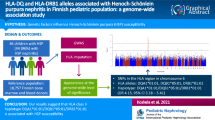Abstract
Henoch Schonlein purpura (HSP) is the most common vasculitis of childhood. Susceptibility to HSP and associated clinical heterogeneity in HSP may be conferred by a number of genetic loci, including the major histocompatibility complex. We aimed to investigate the implications of the human leukocyte antigen (HLA) class 1 alleles in susceptibility to HSP and determine the possible associations with renal, gastrointestinal (GI), and joint manifestations of the disease. 110 children with HSP (66 boys, 44 girls) and 250 unrelated healthy controls were enrolled in the study. The mean age was 8.65 ± 3.59 years. HSP was diagnosed on the basis of clinical and laboratory data according to the American College of Rheumatology classification. The diagnosis was supported with skin and/or kidney in most of the patients. Clinical and laboratory findings revealed: skin involvement in 110 (100%), joint manifestations in 82 (74.5%), GI symptoms in 58 (52.7%), and hematuria and/or proteinuria in 36 (32.7%) patients. HLA class 1 alleles were identified by DNA amplification, hybridized with specific primer sequences. Comparison of frequencies between patients and controls were made by using the Fisher’s exact test. Odds ratio (OR) was used as the measure of association. HLA A2, A11, and B35 antigens showed an increased risk for predisposition to HSP (OR = 1.714, 95%CI = 1.088–2.700, p = 0.020; OR = 2.185, 95%CI = 1.289–3.703, p = 0.003; and OR = 2.292, 95%CI = 1.451–3.619, p = 0.000, respectively), while HLA A1, B49, and B50 antigens revealed decreased risk for predisposition to HSP (OR = 4.739, 95%CI = 1.828–12.345, p = 0.001; OR = 3.268, 95%CI = 0.955–11.236, p = 0.047; and OR = 7.462, 95%CI = 0.975–55.555, p = 0.024, respectively). Considering the renal involvement and severity of proteinuria, there was no association with HLA class 1 alleles. Our results suggest that the increased frequency of HLA A2, A11, and B35 alleles in unselected pediatric HSP patient population and miscarrying of HLA A1, B49, and B50 could be considered as a risk factor for susceptibility to HSP.
Similar content being viewed by others
References
Jin DK, Kohsaka T, Koo JW et al (1996) Complement 4 locus II gene deletion and DQA1*0301 gene: genetic risk factors for IgA nephropathy and Henoch Schonlein nephritis. Nephron 73:390–395
Amoroso A, Berrino M, Canale L et al (1997) Immunogenetics of Henoch–Schonlein disease. Eur J Immunogenet 24:323–333
Amoli MM, Thomson W, Hajeer AH et al (2002) HLA B*35 association with nephritis in Henoch–Schonlein purpura. J Rheumatol 29:948–949
Amoli MM, Thomson W, Hajeer AH et al (2001) HLA-DRB1*01 association with Henoch–Schonlein purpura in patients from Northwest Spain. J Rheumatol 28:1266–1270
Mills JA, Michel BA, Bloch DA et al (1990) The American College of Rheumatology 1990 criteria for the classification of Henoch–Schonlein purpura. Arthritis Rheum 33:1114–1121
Soylemezoglu O, Ozkaya O, Erbas D et al (2002) Nitric oxide in Henoch Schonlein purpura. Scand J Rheumatol 31:271–274
Dababneh A, González-Gay MA, Garcia-Porrua C et al (1998) Giant cell arteritis and polymyalgia rheumatica can be differentiated by distinct patterns of HLA class II association. J Rheumatol 25:2140–2145
Weyand CM, Hicock KC, Hunder GG et al (1992) The HLA DRB1 locus as a genetic component in giant cell arteritis. Mapping of a disease-linked sequence motif to the antigen binding site of the HLA DR molecule. J Clin Invest 90:2355–2361
Weyand CM, Hunder NN, Hicock KC et al (1994) HLA DRB1 alleles in polymyalgia rheumatica, giant cell arteritis, and rheumatoid arthritis. Arthritis Rheum 37:514–520
Combe B, Sany J, Le Quellec A et al (1998) Distribution of HLA DRB1 alleles of patients with polymyalgia rheumatica and giant cell arteritis in a Mediterranean population. J Rheumatol 25:94–98
Rauzy O, Fort M, Nourhashemi F et al (1998) Relation between HLA DRB1 alleles and corticosteroid resistance in giant cell arteritis. Ann Rheum Dis 57:380–382
Gonzalez-Gay MA, Garcia-Porrua C, Llorca J, Hajeer AH et al (2000) Visual manifestations of giant cell arteritis. Trends and clinical spectrum in 161 patients. Medicine (Baltimore) 5:283–292
Glass D, Soter NA, Gibson D et al (1976) Association between HLA and cutaneous necrotizing venulitis. Arthritis Rheum 19:945–949
Ostergaard JR, Storm K, Lamm LU (1990) Lack of association between HLA and Schonlein–Henoch purpura. Tissue Antigens 35:234–235
Nathwani D, Laing RB, Smith CC et al (1992) Recurrent post-infective Henoch Schonlein syndrome: a genetic influence related to HLA B35?. J Infect 25:205–210
Nyulassy S, Buc M, Sasinka M et al (1977) The HLA system in glomerulonephritis. Clin Immunol Immunopathol 7:319–323
Freycon MT, Parchoux B, Dechelette E et al (1984) HLA and rheumatoid purpura with or without nephropathy. Pediatrie 39:525–532
Arellano J, Ojeda S, Vargas R et al (1990) Histocompatibility antigens and acute vascular purpura. Bol Med Hosp Infant Mex 47:620–623
Author information
Authors and Affiliations
Corresponding author
Rights and permissions
About this article
Cite this article
Peru, H., Soylemezoglu, O., Gonen, S. et al. HLA class 1 associations in Henoch Schonlein purpura: increased and decreased frequencies. Clin Rheumatol 27, 5–10 (2008). https://doi.org/10.1007/s10067-007-0640-z
Received:
Revised:
Accepted:
Published:
Issue Date:
DOI: https://doi.org/10.1007/s10067-007-0640-z



